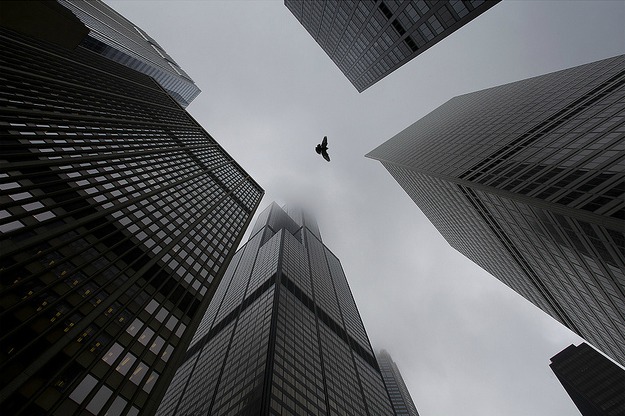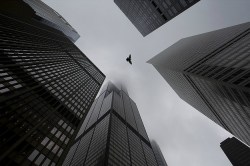Dave Willard guides the way into a room within Chicago’s Field Museum of Natural History, where the scene inside is at once ghastly and gorgeous. Soft down floats in the air as chatty biologists tear fistfuls of feathers from corpses of birds large and small. This day’s work: sparrows, warblers, thrushes, sapsuckers, and creepers, all among the 3,000 birds collected from last fall’s migration.
It is Wednesday, “prep day” at the museum’s Bird Preparation Lab, the small quarters where Willard, a 66-year-old biologist specializing in ornithology, leads the nation’s most extensive study of migratory birds, most killed by brutal concussion when hitting windows at flight speeds of up to 65 miles per hour.
Because of its location on migratory routes, Chicago’s skyline kills more birds than any other in the country. Navigating by the stars and hungry after flights from as far away as Peru, the birds arrive on Lake Michigan’s shoreline in search of food. There, the twinkling city and its canyons become a death trap.
Now, stripped down to the burgundy-brown musculature veined with tissue, the birds are lined up on cafeteria trays, their china-like frames reminiscent of a hat-and-cane vaudeville dance act. There’s a perfume of sweet meat, mothballs, and rot. As the biologists pluck and eviscerate, they sip coffee and talk about football and politics. Then someone carries in a paper tray of what looks to be — yes, chicken nuggets.
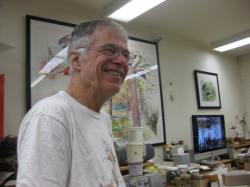
Dave Willard.
Willard’s salvaging work spans 33 years, during which he has collected and prepped thousands of birds whose bodies or skeletons will, over time, give us cues about environmental change. Fewer individuals of a species could point to population declines. Earlier in-migrations and later departures may be an indication of global warming. The increasing number of smaller birds found, noted by their skeletal size, may be a sign that they are adapting to rising temperatures.
While the number of casualties has been in decline since skyscrapers and high-rises began turning off lights during migratory seasons in 2004, the lab takes in about 5,000 birds yearly. And of the 64,000 this lab has handled, half died hitting the face of one building: McCormick Place, a low-rise, black steel and glass Death Star perched on the shoreline of Lake Michigan.
Long before “lights out” programs, which began in Chicago, Willard was told that the building was taking migratory flocks in untold numbers. That’s when he began his daily migration trek, setting out before dawn in rain, sleet, or snow to the lakeside base of McCormick Place. Visit after visit turned up more birds, many rare: Northern saw-whet owls, American woodcocks, ovenbirds, black rails, painted buntings, white-throated sparrows, Tennessee warblers. He recalls hearing thwacks against the glass while gathering the dead and injured.
McCormick Place has greatly reduced the number of nights its lights are on, but some remain on, and its lakeside location and glass façade make it a bird magnet. And so Willard contents himself to collect the corpses and use them to study migration “instead of having them swept into a dumpster.”
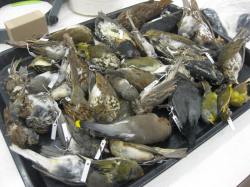
Willard and the museum team collect hundreds of birds, their vitals hand-logged in books now numbering in the hundreds. The birds are then identified, numbered, then ziplock-bagged and frozen. Still more are delivered by members of the Chicago Bird Collision Monitors who comb the city’s streets for migration casualties, storing them in kitchen freezers, hidden among pints of ice cream and frozen pizzas.
On prep day, a batch is thawed in the lab and the work begins. Snippets of breast tissue are taken for DNA; feathers and toenail clippings are logged. Their isotopes reveal what the bird ate during its molt and growth, helping pinpoint where it wintered or summered. Remains are then carried to a room marked Dermestid Beetle Colony (“It doesn’t smell great in here,” Willard sings out as he leads me inside) where hundreds of thousands of the small, black, hard-shelled carrion critters dine, cleaning bird carcasses to the bone in less than a day.
Once the beetles are done, the skeletons are placed in a dilute solution of ammonium hydroxide for a total cleaning. Beautifully alabaster, the bones are painstakingly and individually numbered and stored in small, brown, jewel boxes.
It’s a labor of love for the Willard lab. Consider that some members confess to having made “gamey but flavorful” soup stock from birds killed in the field as to not waste them.
Willard’s studies have turned up both bad news and good: Once abundant field sparrows are now rarely found, helping to show the decline in grassland species. On the upside, lights-out programs are decreasing the numbers of deaths. The number of birds killed at McCormick Place dropped from a high from 2,400 in the early 1990s to 400 for last year’s spring and fall migrations.
More importantly, Chicago has taken note of its threat to birds and is working to provide them safe passage. Architect Jeanne Gang has designed plans to turn more than 40 acres of Northerly Island, just off of the shore, into lush habitat, hoping to pull migrating birds away from the buildings. Several miles of parkland along South Lake Shore Drive are also slated to become bird habitat.
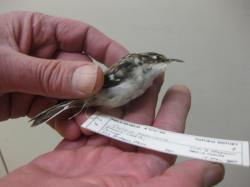
The brown creeper.
Of the thousands of birds that Willard’s team inspects, a few attain places of special reverence. Willard opens a drawer where a pinky-sized brown creeper lies as if asleep. Found by a collision monitor on April 17, 2009, along the city’s North Michigan Avenue, the creeper weighs less than a drinking straw. The birds are so small that they’re rarely seen in flight.
When this particular bird was found, one leg was banded, denoting that it had once survived a window strike, recovered, and was set free. Records showed that exactly one year before its death, the bird had hit another building, also on North Michigan Avenue, no more than two blocks away from the window that would mark its final flight.
The April 17 creeper wasn’t sent to the beetle room. It was carefully skinned, cleaned, stuffed with cotton, and sewed back together — and placed in a drawer, deeply respected for the story it told.

